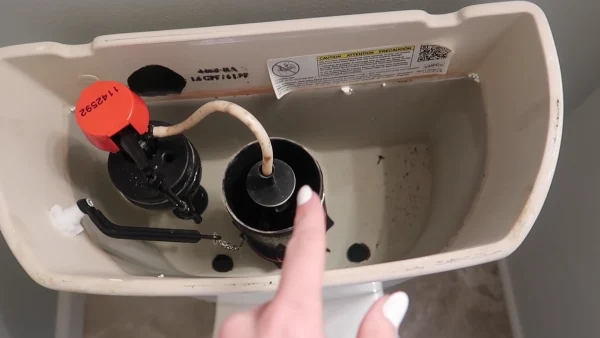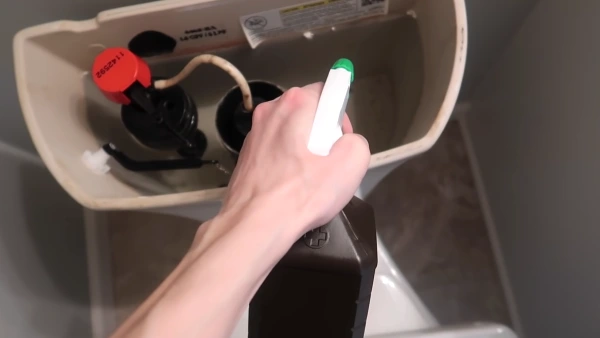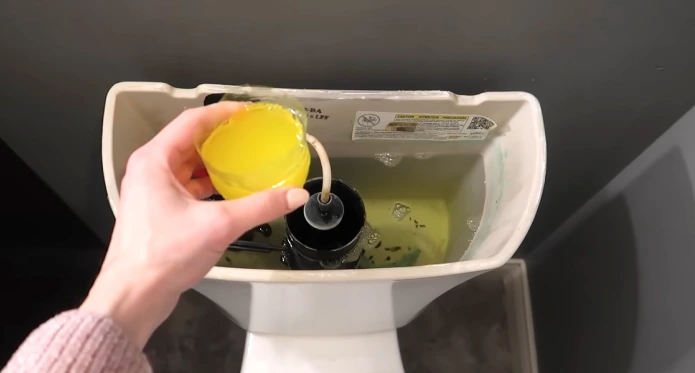Last Updated on October 18, 2023
Keeping your toilet tank clean and disinfected is important for maintaining good hygiene in your home. So many of us reach for bleach when cleaning toilets. But should you really put bleach in a toilet tank to maintain a clean and healthy space?
Using bleach or products containing bleach inside the toilet tank is unquestionably unsafe, as it can harm the rubber and plastic components. The corrosive nature of bleach can also lead to rust stains on metal bolts, further compromising the integrity of your toilet tank.
Throughout this article, we will explore why you should avoid using bleach in the toilet tank. Also, discuss alternatives to maintain a hygienic and sanitary toilet.
Why Shouldn’t You Put Bleach in the Toilet?

Although you may think that bleach is a powerful cleaning agent, there are potential risks and drawbacks. These include:
- Damage to rubber components
- Harmful fumes
- Weakening of plastic parts
- Corrosion of metal bolts
- Potential discoloration
Now let’s talk about these reasons:
Damage to Rubber Components
Using bleach in the toilet tank can cause damage to the rubber components, making them more prone to leaks and inefficiency. The harsh chemicals in bleach can deteriorate the rubber seals and gaskets crucial for maintaining a watertight seal in the tank.
Over time, these parts become brittle and weakened, increasing the risk of water leaks and inefficiency in flushing. When the rubber components fail, water can constantly leak out of the tank or escape through small cracks, wasting water and potentially ruining your bathroom floor.
Harmful Fumes
Mixing bleach with other substances in an enclosed space like the toilet tank can result in harmful fumes that may pose a risk to your health. These fumes can irritate your respiratory system and may cause difficulty breathing, coughing, and even asthma attacks in sensitive individuals.
Inhaling these fumes can also lead to eye discomfort and skin irritation. Also, you should never mix bleach with ammonia, vinegar, or other cleaning products containing acids or ammonia-based compounds.
Weakening of Plastic Parts
The plastic components in the toilet can be weakened by bleach, potentially causing malfunctions in the flushing mechanism. When bleach interacts with toilet plastic parts like the fill valve and overflow tube, it can break down the structural integrity of these components over time.
This weakening of the plastic parts may result in leaks, clogs, or even complete failure of the flushing mechanism. To avoid such issues, it is recommended to use alternative cleaning agents specifically designed for toilets that are safe for plastic components.
Corrosion of Metal Bolts
When bleach comes into contact with metal bolts, it can also cause corrosion and weaken the connections holding the toilet together. Corroded metal bolts are a serious concern as they can lead to toilet leaks and potential damage.
The corrosive properties of bleach can eat away at the protective coatings on the bolts, exposing them to rust and degradation over time. This can weaken the structural integrity of the bolts, making them more prone to breakage or loosening.
Potential Discoloration
Bleach can dull certain metals found on sinks and faucets and etch some porcelain enamel surfaces. If you pour bleach into your toilet tank, it can also cause discoloration of aluminum components.
The chemicals in bleach can react with these materials, leading to unsightly stains or blemishes that are difficult to remove.
Alternative Cleaners to Bleach for Cleaning Toilet Tanks

For cleaning your toilet tank, there are several alternative cleaners to bleach that you can use, such as:
Vinegar and Baking Soda
Vinegar serves as a natural disinfectant, eliminating harmful bacteria that may be lurking in your tank. It also helps to neutralize unpleasant odors, leaving your bathroom smelling fresh and clean.
Baking soda is a gentle abrasive cleaner that removes stubborn stains and grime from the tank’s surface. Combined with vinegar, these two ingredients create a powerful cleaning solution that breaks down stains and leaves your toilet tank sparkling clean.
Soap and Water
Soap and water are simple yet powerful in removing dirt and grime. This solution has been trusted for generations as a reliable cleaning agent, making it a great choice for maintaining the hygiene of your toilet tank.
Hydrogen Peroxide
Using hydrogen peroxide is a safe and effective way to eliminate bacteria and odors in your toilet. Hydrogen peroxide is a food-safe alternative that can kill bacteria without the harsh chemicals found in bleach.
Commercial Eco-Friendly Cleaners
When looking for a commercial eco-friendly cleaner, check the label to ensure it is safe for septic systems and environmentally friendly. These cleaners are designed to provide effective cleaning without causing harm to the environment or your septic system.
Citric Acid
Citric acid, a natural acid found in citrus fruits, effectively breaks down mineral deposits and stains in the toilet. When dissolved in water and applied to the tank, citric acid works magic by loosening stubborn build-up.
Essential Oils
Essential oils, such as tea tree oil and eucalyptus oil, are known for their delightful scents and antibacterial properties. When added to your cleaning solution, these oils can help eliminate germs and bacteria in your toilet tank.
Can I flush diluted bleach down the toilet?
You can safely flush diluted bleach into the toilet. When used in the proper ratio, bleach is an effective disinfectant that can help eliminate bacteria and viruses in your toilet. Diluting the bleach with water before flushing it down the toilet helps to minimize any potential damage to the plumbing system or septic tank.
How long should you leave diluted bleach in the toilet before flushing?
According to professional cleaners, you should wait at least five minutes after bleaching, or even a little longer if you have the time, to eliminate all the germs.
To ensure maximum effectiveness, use your brush to scrub the sides and beneath the bowl’s rim before flushing it all away. This will give the bleach enough time to do its job and kill lingering bacteria.
Never Put Bleach in Toilet Tank to Clean Your Tank
It is highly recommended that you refrain from putting bleach in your toilet tank. Bleach can damage the rubber components inside the tank and cause leaks or malfunctions. Also, the strong chemicals in bleach can harm your health if not used properly.
Instead, consider using alternative cleaners such as vinegar or baking soda for a safe and effective cleaning solution. By following these tips, you can maintain the health and longevity of your toilet and ensure the safety of your family.

